2021 HYUNDAI SANTA FE LIMITED belt
[x] Cancel search: beltPage 564 of 636
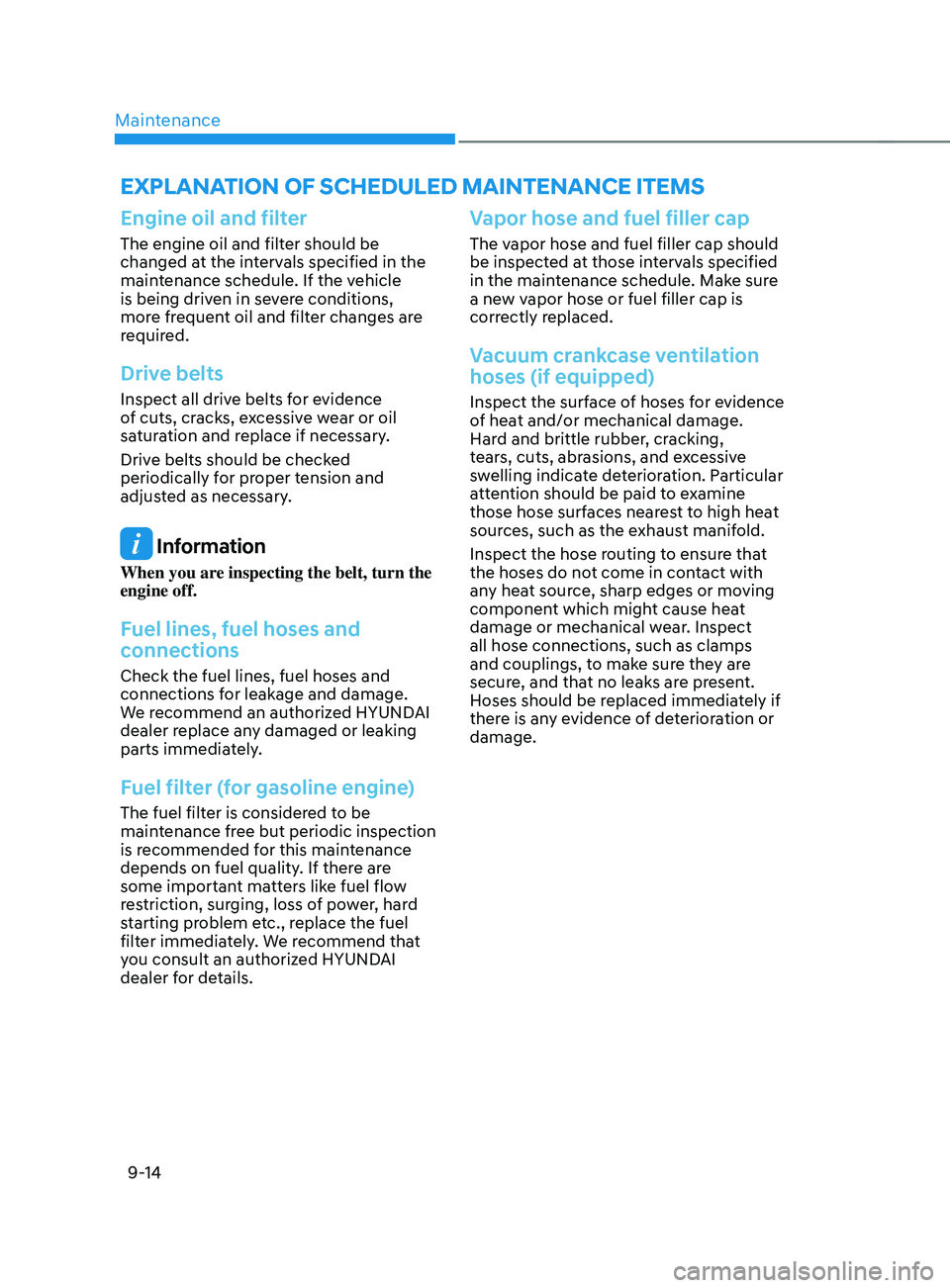
Maintenance
9-14
Engine oil and filter
The engine oil and filter should be
changed at the intervals specified in the
maintenance schedule. If the vehicle
is being driven in severe conditions,
more frequent oil and filter changes are
required.
Drive belts
Inspect all drive belts for evidence
of cuts, cracks, excessive wear or oil
saturation and replace if necessary.
Drive belts should be checked
periodically for proper tension and
adjusted as necessary.
Information
When you are inspecting the belt, turn the
engine off.
Fuel lines, fuel hoses and
connections
Check the fuel lines, fuel hoses and
connections for leakage and damage.
We recommend an authorized HYUNDAI
dealer replace any damaged or leaking
parts immediately.
Fuel filter (for gasoline engine)
The fuel filter is considered to be
maintenance free but periodic inspection
is recommended for this maintenance
depends on fuel quality. If there are
some important matters like fuel flow
restriction, surging, loss of power, hard
starting problem etc., replace the fuel
filter immediately. We recommend that
you consult an authorized HYUNDAI
dealer for details.
Vapor hose and fuel filler cap
The vapor hose and fuel filler cap should
be inspected at those intervals specified
in the maintenance schedule. Make sure
a new vapor hose or fuel filler cap is
correctly replaced.
Vacuum crankcase ventilation
hoses (if equipped)
Inspect the surface of hoses for evidence
of heat and/or mechanical damage.
Hard and brittle rubber, cracking,
tears, cuts, abrasions, and excessive
swelling indicate deterioration. Particular
attention should be paid to examine
those hose surfaces nearest to high heat
sources, such as the exhaust manifold.
Inspect the hose routing to ensure that
the hoses do not come in contact with
any heat source, sharp edges or moving
component which might cause heat
damage or mechanical wear. Inspect
all hose connections, such as clamps
and couplings, to make sure they are
secure, and that no leaks are present.
Hoses should be replaced immediately if
there is any evidence of deterioration or
damage.
ExPLANATION OF SCHEDULED MAINTENANCE ITEMS
Page 588 of 636
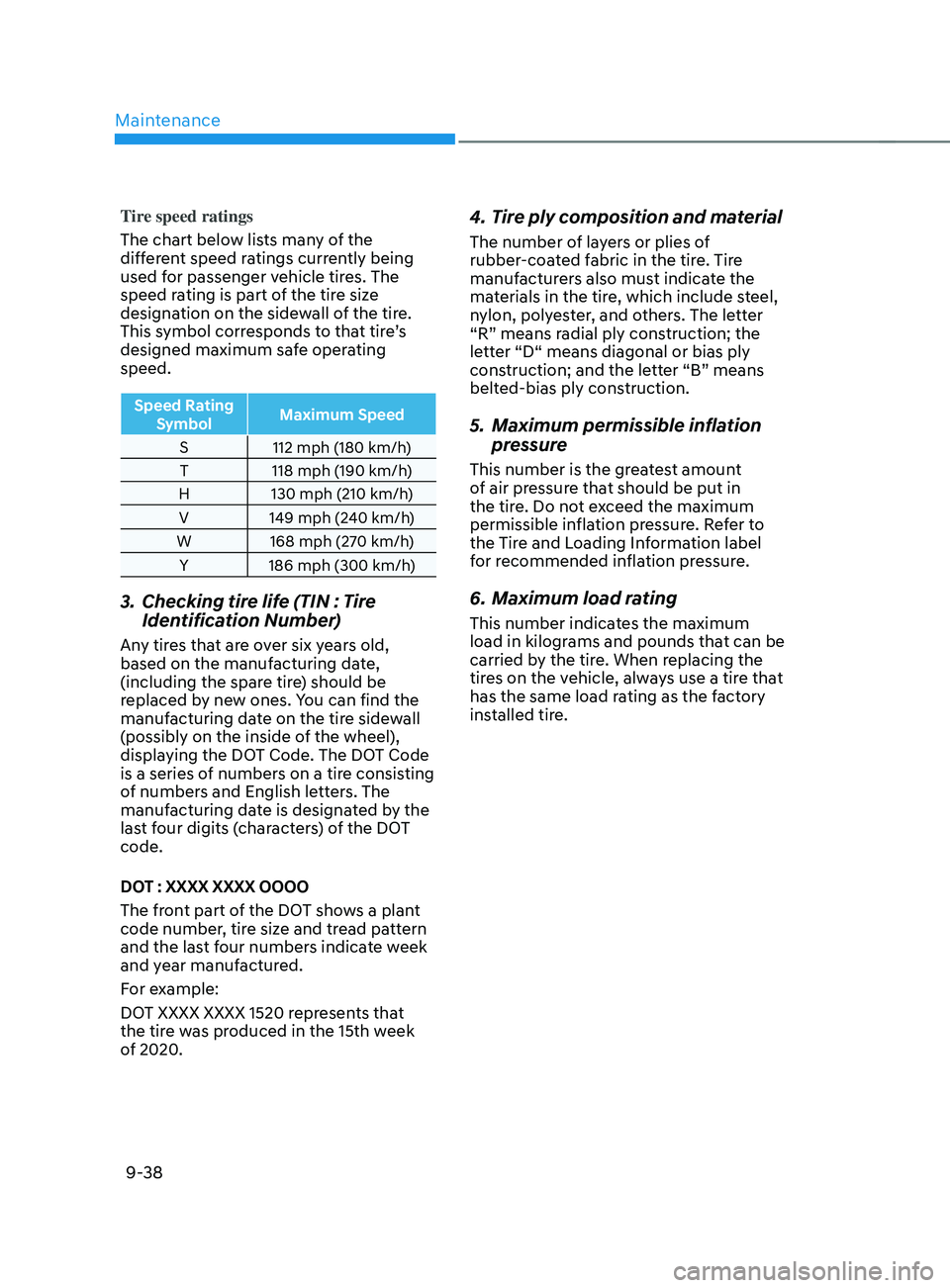
Maintenance
9-38
Tire speed ratings
The chart below lists many of the
different speed ratings currently being
used for passenger vehicle tires. The
speed rating is part of the tire size
designation on the sidewall of the tire.
This symbol corresponds to that tire’s
designed maximum safe operating
speed.
Speed Rating Symbol Maximum Speed
S 112 mph (180 km/h)
T 118 mph (190 km/h)
H 130 mph (210 km/h)
V 149 mph (240 km/h)
W 168 mph (270 km/h) Y 186 mph (300 km/h)
3. Checking tire lif e (TIN : Tire
Identification Number)
Any tires that are over six years old,
based on the manufacturing date,
(including the spare tire) should be
replaced by new ones. You can find the
manufacturing date on the tire sidewall
(possibly on the inside of the wheel),
displaying the DOT Code. The DOT Code
is a series of numbers on a tire consisting
of numbers and English letters. The
manufacturing date is designated by the
last four digits (characters) of the DOT
code.
DOT : XXXX XXXX OOOO
The front part of the DOT shows a plant
code number, tire size and tread pattern
and the last four numbers indicate week
and year manufactured.
For example:
DOT XXXX XXXX 1520 represents that
the tire was produced in the 15th week
of 2020.
4. Tire ply composition and material
The number of layers or plies of
rubber-coated fabric in the tire. Tire
manufacturers also must indicate the
materials in the tire, which include steel,
nylon, polyester, and others. The letter
“R” means radial ply construction; the
letter “D“ means diagonal or bias ply
construction; and the letter “B” means
belted-bias ply construction.
5. Maximum permissible inflation
pr essure
This number is the greatest amount
of air pressure that should be put in
the tire. Do not exceed the maximum
permissible inflation pressure. Refer to
the Tire and Loading Information label
for recommended inflation pressure.
6. Maximum load rating
This number indicates the maximum
load in kilograms and pounds that can be
carried by the tire. When replacing the
tires on the vehicle, always use a tire that
has the same load rating as the factory
installed tire.
Page 617 of 636
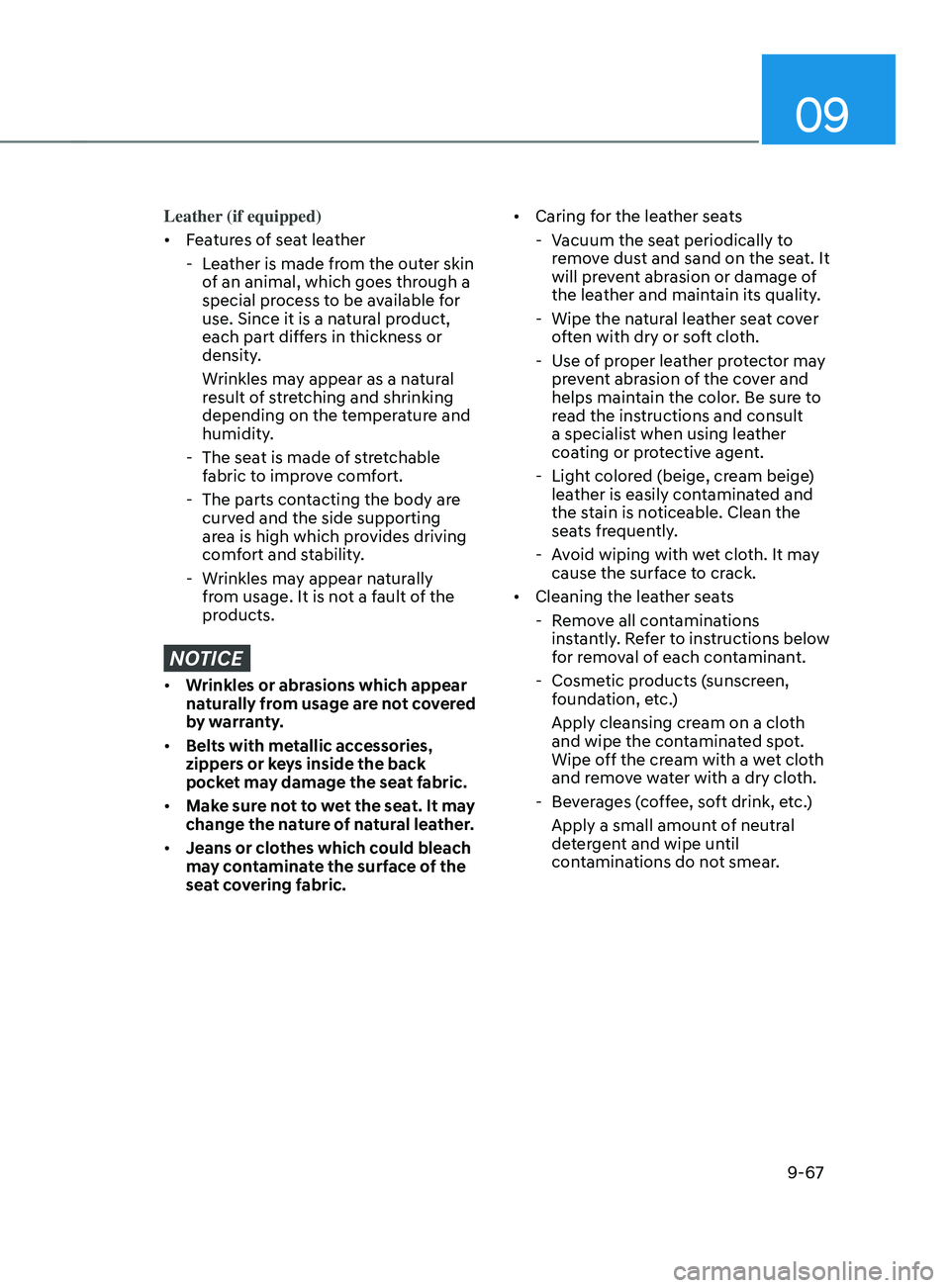
09
9-67
Leather (if equipped)
• Features of seat leather
- Lea
ther is made from the outer skin
of an animal, which goes through a
special process to be available for
use. Since it is a natural product,
each part differs in thickness or
density.
Wrinkles may appear as a natural
result of stretching and shrinking
depending on the temperature and
humidity.
- The seat is made o
f stretchable
fabric to improve comfort.
- The parts contacting the body ar
e
curved and the side supporting
area is high which provides driving
comfort and stability.
- Wrinkles ma
y appear naturally
from usage. It is not a fault of the
products.
NOTICE
• Wrinkles or abrasions which appear
naturally from usage are not covered
by warranty.
• Belts with metallic accessories,
zippers or keys inside the back
pocket may damage the seat fabric.
• Make sure not to wet the seat. It may
change the nature of natural leather.
• Jeans or clothes which could bleach
may contaminate the surface of the
seat covering fabric. •
Caring for the leather seats
- Vacuum the sea
t periodically to
remove dust and sand on the seat. It
will prevent abrasion or damage of
the leather and maintain its quality.
- Wipe the natur
al leather seat cover
often with dry or soft cloth.
- Use o
f proper leather protector may
prevent abrasion of the cover and
helps maintain the color. Be sure to
read the instructions and consult
a specialist when using leather
coating or protective agent.
- Light color
ed (beige, cream beige)
leather is easily contaminated and
the stain is noticeable. Clean the
seats frequently.
- Av
oid wiping with wet cloth. It may
cause the surface to crack.
• Cleaning the leather seats
- Remo
ve all contaminations
instantly. Refer to instructions below
for removal of each contaminant. - Cosmetic pr oducts (sunscreen,
foundation, etc.)
Apply cleansing cream on a cloth
and wipe the contaminated spot.
Wipe off the cream with a wet cloth
and remove water with a dry cloth.
- Bev
erages (coffee, soft drink, etc.)
Apply a small amount of neutral
detergent and wipe until
contaminations do not smear.
Page 618 of 636
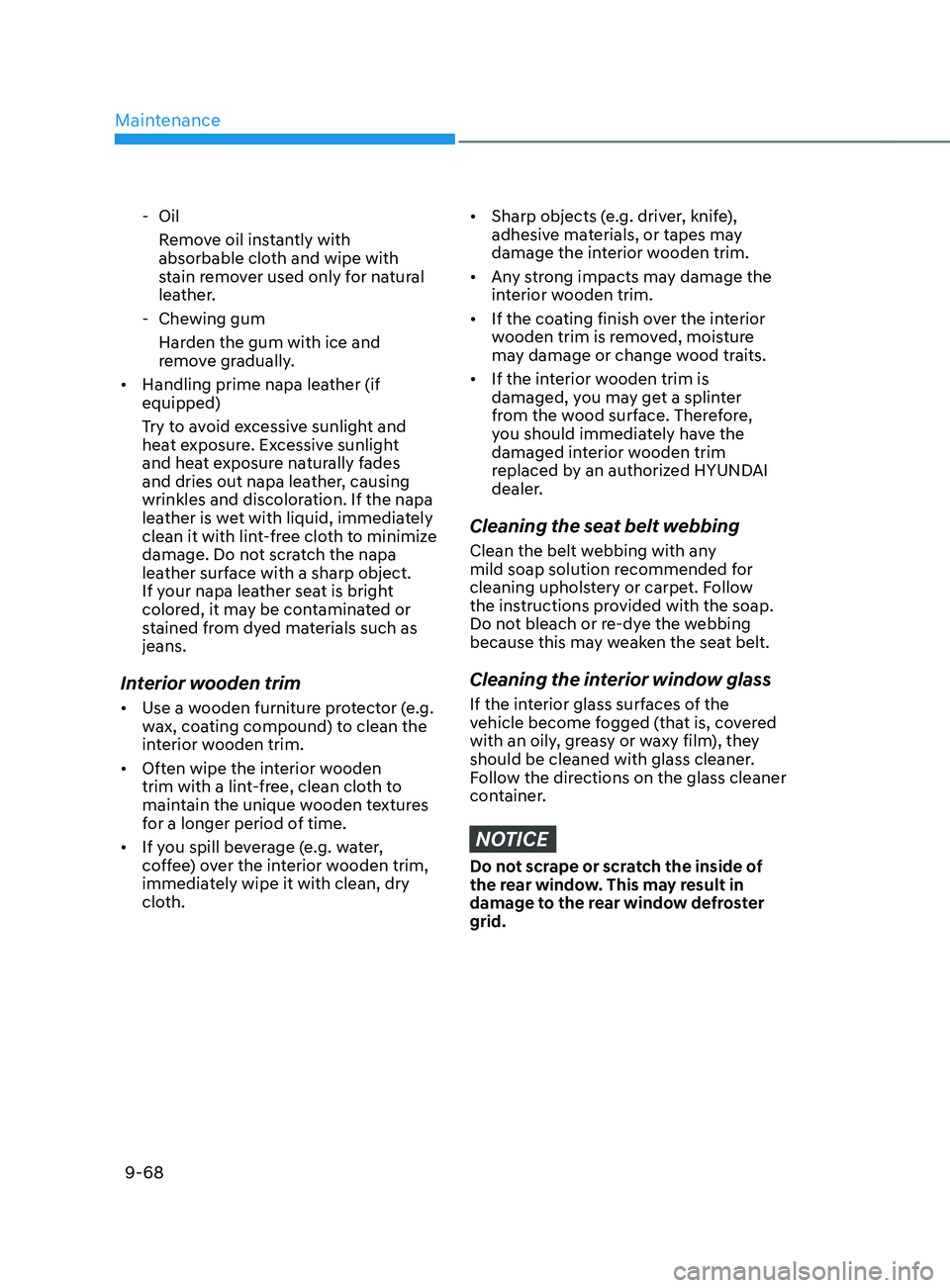
Maintenance
9-68
- OilRemo ve oil instantly with
absorbable cloth and wipe with
stain remover used only for natural
leather.
- Chewing gum
Har
den the gum with ice and
remove gradually.
• Handling prime napa leather (if
equipped)
Try to avoid excessive sunlight and
heat exposure. Excessive sunlight
and heat exposure naturally fades
and dries out napa leather, causing
wrinkles and discoloration. If the napa
leather is wet with liquid, immediately
clean it with lint-free cloth to minimize
damage. Do not scratch the napa
leather surface with a sharp object.
If your napa leather seat is bright
colored, it may be contaminated or
stained from dyed materials such as
jeans.
Interior wooden trim
• Use a wooden furniture protector (e.g.
wax, coating compound) to clean the
interior wooden trim.
• Often wipe the interior wooden
trim with a lint-free, clean cloth to
maintain the unique wooden textures
for a longer period of time.
• If you spill beverage (e.g. water,
coffee) over the interior wooden trim,
immediately wipe it with clean, dry
cloth.
• Sharp objects (e.g. driver, knife),
adhesive materials, or tapes may
damage the interior wooden trim.
• Any strong impacts may damage the
interior wooden trim.
• If the coating finish over the interior
wooden trim is removed, moisture
may damage or change wood traits.
• If the interior wooden trim is
damaged, you may get a splinter
from the wood surface. Therefore,
you should immediately have the
damaged interior wooden trim
replaced by an authorized HYUNDAI
dealer.
Cleaning the seat belt webbing
Clean the belt webbing with any
mild soap solution recommended for
cleaning upholstery or carpet. Follow
the instructions provided with the soap.
Do not bleach or re-dye the webbing
because this may weaken the seat belt.
Cleaning the interior window glass
If the interior glass surfaces of the
vehicle become fogged (that is, covered
with an oily, greasy or waxy film), they
should be cleaned with glass cleaner.
Follow the directions on the glass cleaner
container.
NOTICE
Do not scrape or scratch the inside of
the rear window. This may result in
damage to the rear window defroster
grid.
Page 622 of 636
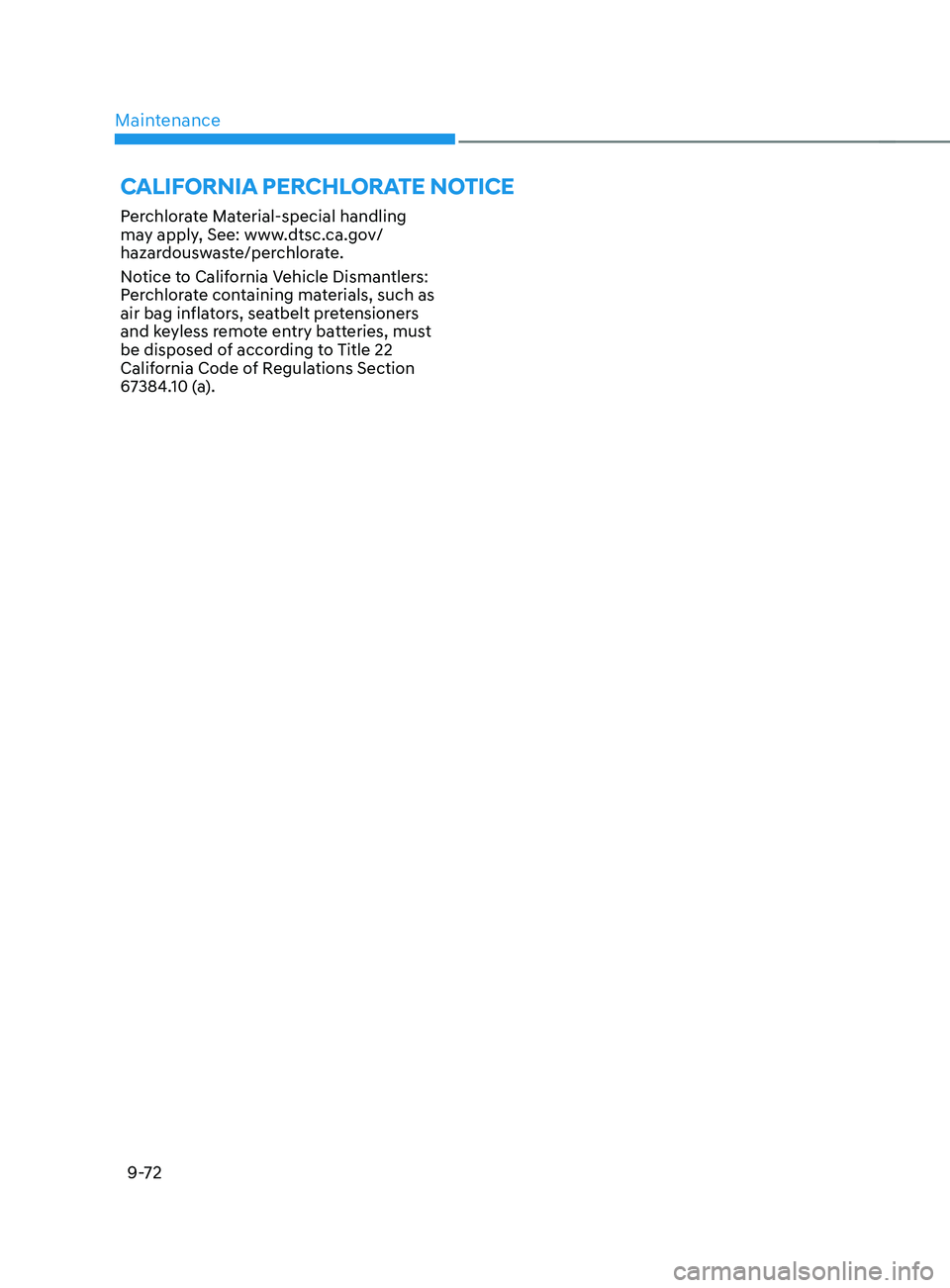
Maintenance9-72
CALIFORNIA PERCHLORATE NOTICE
Perchlorate Material-special handling
may apply, See: www.dtsc.ca.gov/
hazardouswaste/perchlorate.
Notice to California Vehicle Dismantlers:
Perchlorate containing materials, such as
air bag inflators, seatbelt pretensioners
and keyless remote entry batteries, must
be disposed of according to Title 22
California Code of Regulations Section
67384.10 (a).
Page 629 of 636

I
I -7
I
Idle Stop and Go (ISG)
........................................................................\
...............6-61
Forced to restart engine ........................................................................\
............6-64
ISG malfunction ........................................................................\
....................... 6-65
ISG system off ........................................................................\
.......................... 6-64
ISG system operation ........................................................................\
...............6-61
If the engine overheats
........................................................................\
................... 8-7
If the engine will not start
........................................................................\
.............. 8-3
If you have a flat tire (with spare tire)
................................................................. 8-14
Changing tires ........................................................................\
.......................... 8-16
Jack and tools ........................................................................\
........................... 8-14
Jack label ........................................................................\
.................................. 8-21
Removing and storing the spare tire .................................................................8-14
If you have a flat tire (with
Tire Mobility Kit)
.................................................... 8-22
Checking the tire inflation pressure ................................................................. 8-28
Components of the T
ire Mobility Kit
............................................................... 8-24
Introduction ........................................................................\
.............................. 8-22
Notes on the safe use of the T
ire Mobility Kit
.................................................8-23
Using the T
ire Mobility Kit
........................................................................\
...... 8-25
Ignition switch
........................................................................\
............................... 6-5
Key ignition switch ........................................................................\
....................6-5
Key ignition switch positions ........................................................................\
.....6-6
Starting the engine ........................................................................\
...................... 6-7
Important safety precautions
........................................................................\
.......... 3-2
Air bag hazards ........................................................................\
........................... 3-2
Always wear your seat belt ........................................................................\
........3-2
Control your speed ........................................................................\
..................... 3-2
Driver distraction ........................................................................\
........................ 3-2
Keep your vehicle in safe condition ...................................................................3-2
Restrain all children ........................................................................\
................... 3-2
In case of an emer
gency while driving
.................................................................. 8-2
If the engine stalls at a crossroad or crossing .....................................................8-2
If the engine stalls while driving ........................................................................\
8-2
If you have a flat tire while driving ....................................................................8-3
Page 634 of 636
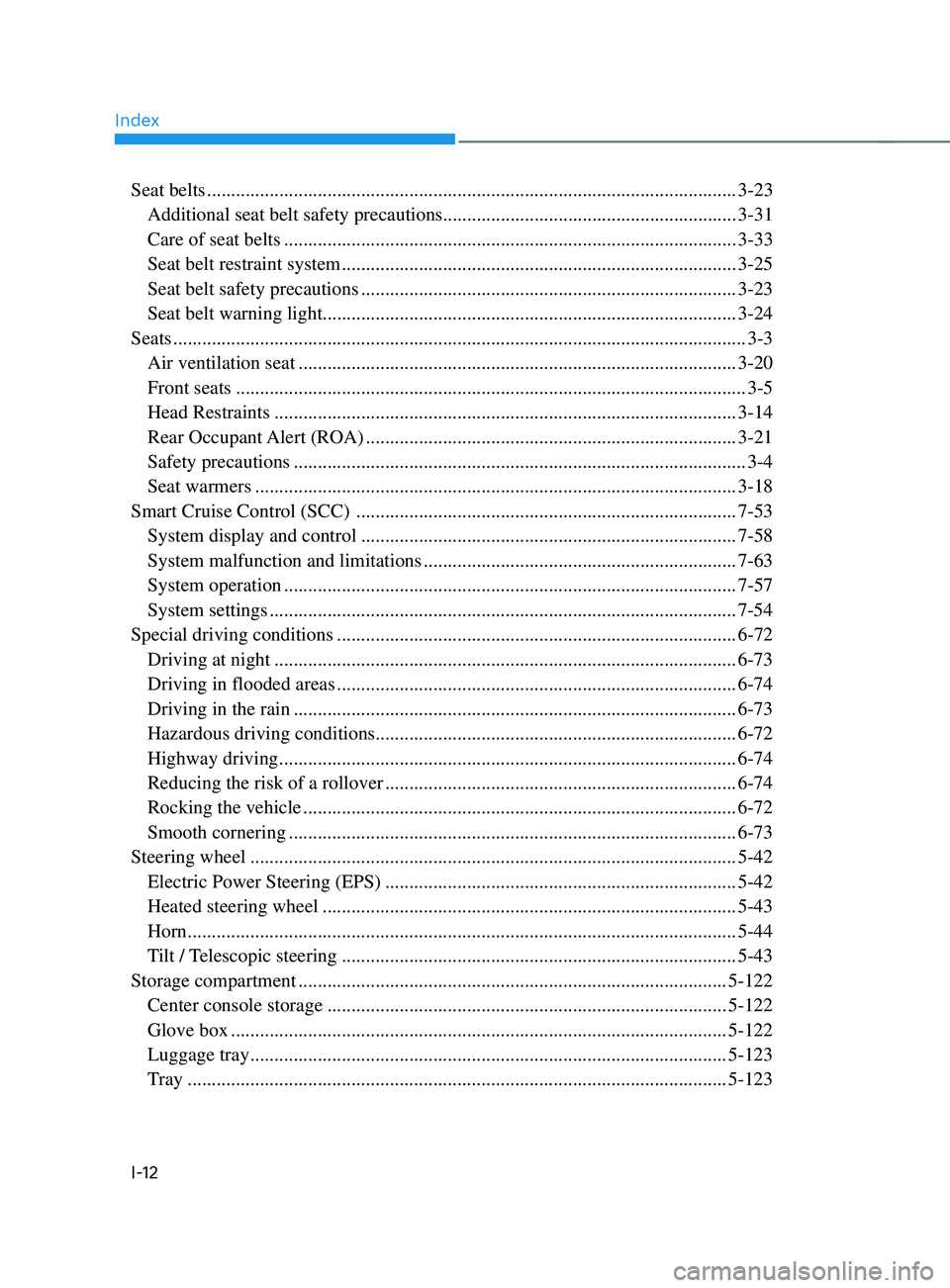
Index
I-12
Seat belts ........................................................................\
......................................3-23
Additional seat belt safety precautions .............................................................3-31
Care of seat belts ........................................................................\
...................... 3-33
Seat belt restraint system ........................................................................\
..........3-25
Seat belt safety precautions ........................................................................\
......3-23
Seat belt warning light ........................................................................\
.............. 3-24
Seats
........................................................................\
............................................... 3-3
Air ventilation seat ........................................................................\
...................3-20
Front seats ........................................................................\
.................................. 3-5
Head Restraints ........................................................................\
........................3-14
Rear Occupant Alert (ROA) ........................................................................\
.....3-21
Safety precautions ........................................................................\
...................... 3-4
Seat warmers ........................................................................\
............................ 3-18
Smart Cruise Control (SCC)
........................................................................\
....... 7-53
System display and control ........................................................................\
......7-58
System malfunction and limitations .................................................................7-63
System operation ........................................................................\
...................... 7-57
System settings ........................................................................\
......................... 7-54
Special driving conditions
........................................................................\
........... 6-72
Driving at night ........................................................................\
........................ 6-73
Driving in flooded areas ........................................................................\
...........6-74
Driving in the rain ........................................................................\
.................... 6-73
Hazardous driving conditions ........................................................................\
...6-72
Highway driving ........................................................................\
....................... 6-74
Reducing the risk of a rollover ........................................................................\
.6-74
Rocking the vehicle ........................................................................\
.................. 6-72
Smooth cornering ........................................................................\
..................... 6-73
Steering wheel
........................................................................\
............................. 5-42
Electric Power Steering (EPS) ........................................................................\
.5-42
Heated steering wheel ........................................................................\
.............. 5-43
Horn ........................................................................\
.......................................... 5-44
Tilt /
Telescopic steering
........................................................................\
.......... 5-43
Storage compartment
........................................................................\
................. 5-122
Center console storage ........................................................................\
...........5-122
Glove box ........................................................................\
............................... 5-122
Luggage tray ........................................................................\
...........................5-123
T
ray
........................................................................\
........................................ 5-123